Toyota Highlander Service Manual: On-vehicle inspection
1. INSPECT DRIVE BELT

(a) Visually check the belt for excessive wear, frayed cords, etc.
If any defect is found, replace the drive belt.
HINT: Cracks on the rib side of a belt are considered acceptable. Replace the belt if there are any missing ribs.
2. CHECK FLUID LEVEL

(a) Keep the vehicle level.
(b) With the engine stopped, check the fluid level in the oil reservoir. If necessary, add fluid.
Fluid: ATF DEXRON II or III
HINT: When hot, check that the fluid level is within the HOT LEVEL range on the reservoir.
If the fluid is cold, check that it is within the COLD LEVEL range.
(c) Start the engine and run at idle.
(d) Turn the steering wheel from lock to lock several times to raise fluid temperature.
Fluid temperature: 75 to 80 C (167 to 176 F)

(e) Check for foaming or emulsification.
If foaming or emulsification is identified, bleed air in the power steering system (see step 3).

(f) With the engine idling, measure the fluid level in the reservoir.
(g) Stop the engine.
(h) Wait a few minutes and measure the fluid level in the reservoir again.
Maximum fluid level rise: 5 mm (0.20 in.) or less
If the fluid level rise exceeds the maximum, bleed air in the power steering system (see step 3).
(i) Check the fluid level.
3. BLEED AIR IN POWER STEERING SYSTEM
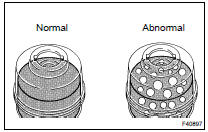
NOTICE: If you replace or separate the components for power steering oil pressure line, bleed air in the power steering system after the operation.
(a) Idle the engine at 1,000 rpm or less until bubbles in the fluid disappear. (Be sure not to turn the steering wheel.) (b) When the bubbles disappear, slowly turn the steering wheel from lock to lock 2 or 3 times.
(c) Repeat procedures (a) and (b) until the fluid level in the reservoir becomes stable and bubbles disappear. If the fluid level goes below the MAX line, add fluid.
(d) When the fluid level becomes stable, increase and decrease oil pressure 2 or 3 times for both left and right by turning the steering wheel to the full lock positions and jiggling it there.
(e) Make sure that no bubbles exist in the reservoir. When turning the steering wheel quickly or turning it from lock to lock position, check that the steering wheel is not heavy to turn and there is no abnormal noise or vibration.
(f) When there are fluid leaks or abnormalities after bleeding air, repair them and repeat procedures (a) to (e). If the abnormalities still exist, replace the related parts.
4. CHECK STEERING FLUID PRESSURE
(a) Disconnect the pressure feed tube assy (see page 30-3 ).
(b) Connect SST, as shown in the illustration on the next page.
SST 09640-10010 (09641-01010, 09641-01020, 09641-01030)
NOTICE: Check that the valve of the SST is in the open position.
(c) Bleed the power steering system.
(d) Start the engine and run at idle.
(e) Turn the steering wheel from lock to lock several times to raise fluid temperature.
Fluid temperature: 75 to 80C (167 to 176F)

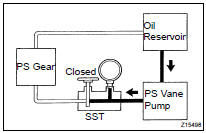
(f) With the engine idling, close the valve of the SST and observe the reading on the SST.
Fluid pressure: 7,800 to 8,300 kPa (80 to 85 kgf/cm2, 1,131 to 1,204 psi)
NOTICE:
- Do not keep the valve closed for more than 10 seconds.
- Do not allow the fluid temperature to become too high.
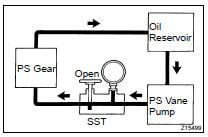
(g) With the engine idling, open the valve fully.
(h) Measure the fluid pressure at engine speeds of 1,000 rpm and 3,000 rpm.
Difference in fluid pressure: 490 kPa (5 kgf/cm2, 71 psi) or less
NOTICE: Do not turn the steering wheel.
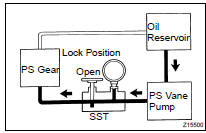
(i) With the engine idling and the valve fully opened, turn the steering wheel to the left or right full lock position.
Fluid pressure: 7,800 to 8,300 kPa (80 to 85 kgf/cm2, 1,131 to 1,204 psi)
NOTICE:
- Do not keep the steering wheel in the full lock position for more than 10 seconds.
- Do not allow the fluid temperature to become too high.
(j) Disconnect the SST.
SST 09640- 10010 (09641- 01010, 09641- 01020, 09641-01030)
(k) Connect the pressure feed tube assy (see page 30-3 ).
(l) Bleed the power steering system (see step 3).
5. CHECK STEERING EFFORT
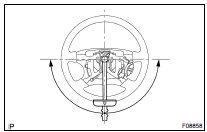
(a) Center the steering wheel.
(b) Remove the steering wheel pad (see page 60-17 ).
(c) Start the engine and run it at idle.
(d) Measure the steering effort in both directions.
Steering effort (Reference): 6.0 N*m (60 kgf*cm, 53 in.*lbf) or less
HINT: Check tire type, pressure and road surface before making your diagnosis.
(e) Tighten the steering wheel set nut.
Torque: 51 N*m (520 kgf*cm, 38 ft*lbf)
(f) Install the steering wheel pad (see page 60-17 ).
(g) Clear the DTCs (see page 05-1215 ).
(h) Inspect the airbag warning light (see page 05-1207 ).
 Problem symptoms table
Problem symptoms table
HINT:
Use the table below to help determine the cause of the problem. The numbers
indicate likely causes of the
problem in descending order. Check each part in order. Repair or replace parts
as ...
 Vane pump ASSY (2AZ-FE)
Vane pump ASSY (2AZ-FE)
COMPONENTS
OVERHAUL
NOTICE:
Do not overtighten when using a vise.
When installing, coat the parts indicated by the arrows with power
steering fluid
(see page 51-7 ).
1. REMOVE FRON ...
More about Toyota Highlander:
Timing gear case or timing chain case oil
seal (2AZ-FE)
REPLACEMENT
1. REMOVE FRONT WHEEL RH
2. REMOVE FRONT FENDER SPLASH SHIELD FRONT RH
3. REMOVE FRONT FENDER APRON SEAL RH
4. REMOVE ENGINE COVER SUB-ASSY NO.1
5. REMOVE ENGINE MOUNTING STAY NO.2 RH
6. REMOVE ENGINE MOVING CONTROL ROD W/BRACKET (See page 14-24 )
7. REMOVE ENGINE MOUNTING STAY NO ...
